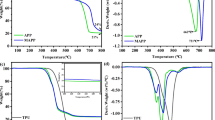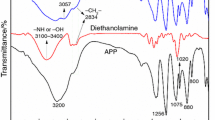Abstract
The surface of ammonium polyphosphate is modified by layered silicates (kaolinite or functionalized kaolinite). The thermogravimetric analysis data confirm that the layered silicates significantly strengthen the thermal stability of polypropylene (PP) and increase the char residue. Fire safety of PP containing different percentages of modified ammonium polyphosphate and charring–foaming agent is assessed by using limiting oxygen index (LOI) and UL-94 vertical combustion. The addition of layered silicates in polymers can effectively enhance the flame-retardant properties including the enhancements in UL-94 rating and LOI results. The flame-retardant mechanism and model are described based on the results of thermal degradation and char residue analysis.










Similar content being viewed by others
References
Hai Y, Jiang S, Qian XD, Zhang SD, Sun P, Xie B, et al. Ultrathin Beta-Nickel hydroxide nanosheets grown along multi-walled carbon nanotubes: A novel nanohybrid for enhancing flame retardancy and smoke toxicity suppression of unsaturated polyester resin. J Colloid Interf Sci. 2018;509:285–97.
He S, Hu Y, Song L, Tang Y. Fire safety assessment of halogen-free flame retardant polypropylene based on cone calorimeter. J Fire Sci. 2007;25(2):109–18.
Dahiya JB, Kumar N, Bockhorn H. Fire performance and thermal stability of polypropylene nanocomposites containing organic phosphinate and ammonium polyphosphate additives. Fire Mater. 2014;38(1):1–12.
Gao SL, Li B, Bai P, Zhang SQ. Effect of polysiloxane and silane-modified SiO2 on a novel intumescent flame retardant polypropylene system. Polym Advan Technol. 2011;22(12):2609–16.
Castrovinci A, Camino G, Drevelle C, Duquesne S, Magniez C, Vouters M. Ammonium polyphosphate-aluminum trihydroxide antagonism in fire retarded butadiene-styrene block copolymer. Eur Polym J. 2005;41(9):2023–33.
Wang Z, Liu Y, Li J. Preparation of nucleotide-based microsphere and its application in intumescent flame retardant polypropylene. J Anal Appl Pyrol. 2016;121:394–402.
Zhang JH, Kong QH, Wang DY. Simultaneously improving the fire safety and mechanical properties of epoxy resin with Fe-CNTs via large-scale preparation. J Mater Chem A. 2018;6(15):6376–86.
Kong QH, Sun YL, Zhang CJ, Guan HM, Zhang JH, Wang DY, et al. Ultrathin iron phenyl phosphonate nanosheets with appropriate thermal stability for improving fire safety in epoxy. Compos Sci Technol. 2019;182:107748–107748.
Yuan BH, Fan A, Yang M, Chen XF, Hu Y, Bao C, et al. The effects of graphene on the flammability and fire behavior of intumescent flame retardant polypropylene composites at different flame scenarios. Polym Degrad Stabil. 2017;143:42–56.
Lim KS, Bee ST, Sin LT, Tee TT, Ratnam CT, Hui D, et al. A review of application of ammonium polyphosphate as intumescent flame retardant in thermoplastic composites. Compos Part B-Eng. 2016;84:155–74.
Wen P, Wang X, Wang B, Yuan B, Zhou K, Song L, et al. One-pot synthesis of a novel s-triazine-based hyperbranched charring foaming agent and its enhancement on flame retardancy and water resistance of polypropylene. Ppolym Degrad Stabil. 2014;110:165–74.
Ding P, Kang B, Zhang J, Yang J, Song N, Tang S, et al. Phosphorus-containing flame retardant modified layered double hydroxides and their applications on polylactide film with good transparency. J Colloid Interf Sci. 2015;440:46–52.
Wang JS, Wang GH, Liu Y, Jiao YH, Liu D. Thermal stability, combustion behavior, and toxic gases in fire effluents of an intumescent flame-retarded polypropylene system. Ind Eng Chem Res. 2014;53(17):6978–84.
Yuan BH, Sun Y, Chen X, Shi Y, Dai H, He S. Poorly-/well-dispersed graphene: abnormal influence on flammability and fire behavior of intumescent flame retardant. Compos Part A-Appl S. 2018;109:345–54.
Yuan BH, Hu Y, Chen X, Shi Y, Niu Y, Zhang Y, et al. Dual modification of graphene by polymeric flame retardant and Ni(OH)2 nanosheets for improving flame retardancy of polypropylene. Compos Part A-Appl S. 2017;100:106–17.
Du B, Ma H, Fang Z. How nano-fillers affect thermal stability and flame retardancy of intumescent flame retarded polypropylene. Polym Advan Technol. 2011;22(7):1139–46.
Lecouvet B, Sclavons M, Bailly C, Bourbigot S. A comprehensive study of the synergistic flame retardant mechanisms of halloysite in intumescent polypropylene. Polym Degrad Stabil. 2013;98(11):2268–81.
Kong QH, Wu T, Zhang HK, Zhang Y, Zhang MM, Si TY, et al. Improving flame retardancy of IFR/PP composites through the synergistic effect of organic montmorillonite intercalation cobalt hydroxides modified by acidified chitosan. Appl Clay Sci. 2017;146:230–7.
Mu X, Zhan J, Ma C, Pan Y, Chu F, Song L, et al. Integrated effect of flame retardant wrapped macromolecular covalent organic nanosheet on reduction of fire hazards of epoxy resin. Compos Part A-Appl S. 2019;117:23–33.
Sun Y, Yuan BH, Chen X, Li K, Wang L, Yun Y, et al. Suppression of methane/air explosion by kaolinite-based multi-component inhibitor. Powder Technol. 2019;343:279–86.
Hou XJ, Li H, Liu Q, Cheng H, He P, Lia S. Theoretical study for the interlamellar aminoalcohol functionalization of kaolinite. Appl Surf Sci. 2015;347:439–47.
Nie S, Yuan H, Lei S, He Q, Yang D, Hao C. Synergistic effect between a char forming agent (CFA) and microencapsulated ammonium polyphosphate on the thermal and flame retardant properties of polypropylene. Polym Advan Technol. 2010;19(8):1077–83.
Tang WF, Li HF, Zhang S, Sun J, Gu XY. The intercalation of ammonium sulfamate into kaolinite and its effect on the fire performance of polypropylene. J Thermoplast Compos. 2018;31(10):1352–70.
Zheng Z, Sun H, Li W, Zhong S, Yan J, Cui X, et al. Co- microencapsulation of ammonium polyphosphate and aluminum hydroxide in halogen- free and intumescent flame retarding polypropylene. Polym Composite. 2014;35(4):715–29.
Zhang Y, Xiang J, Zhang Q, Liu Q, Frost RL. Influence of kaolinite/carbon black hybridization on combustion and thermal decomposition behaviors of NR composites. Thermochim Acta. 2014;576:39–46.
Huang YB, Jiang SH, Liang RC, Sun P, Hai Y, Zhang L. Thermal-triggered insulating fireproof layers: a novel fire-extinguishing MXene composites coating. Chem Eng J. 2020;391:123621.
Li B, Zhan Z, Zhang H, Sun C. Flame retardancy and thermal performance of polypropylene treated with the intumescent flame retardant, piperazine spirocyclic phosphoramidate. J Vinyl Addit Techn. 2014;20(1):10–5.
Shao ZB, Deng C, Tan Y, Chen MJ, Chen L, Wang YZ. An efficient mono-component polymeric intumescent flame retardant for polypropylene: preparation and application. ACS Appl Mater Inter. 2014;6(10):7363–70.
Yan Y, Gu X, Li L, Li H, Sun J, Sheng Z. Preparation and characterization of intumescent flame retardant biodegradable poly(lactic acid) nanocomposites based on sulfamic acid intercalated layered double hydroxides. Fiber Polym. 2017;18(11):2060–9.
Huang Y, Jiang S, Liang R, Liao Z, You G. A green highly-effective surface flame-retardant strategy for rigid polyurethane foam: transforming UV-cured coating into intumescent self-extinguishing layer. Compos Part A-Appl S. 2019;125:105534.
Shi Y, Yu B, Zheng Y, Yang J, Duan Z, Hu Y. Design of reduced graphene oxide decorated with DOPO-phosphanomidate for enhanced fire safety of epoxy resin. J Colloid Interf Sci. 2018;521:160–71.
Wang D, Feng X, Zhang L, Li M, Liu M, Tian A, et al. Cyclotriphosphazene-bridged periodic mesoporous organosilica-integrated cellulose nanofiber anisotropic foam with highly flame-retardant and thermally insulating properties. Chem Eng J. 2019;375:121933.
Shi Y, Yu B, Duan L, Gui Z, Wang B, Hu Y, et al. Graphitic carbon nitride/phosphorus-rich aluminum phosphinates hybrids as smoke suppressants and flame retardants for polystyrene. J Hazard Mater. 2017;332:87–96.
Deng CL, Du SL, Zhao J, Shen ZQ, Deng C, Wang YZ. An intumescent flame retardant polypropylene system with simultaneously improved flame retardancy and water resistance. Polym Degrad Stabil. 2014;108:97–107.
Fang M, Chen Z, Wang S, Lu H. The deposition of iron and silver nanoparticles in graphene–polyelectrolyte brushes. Nanotechnology. 2012;23(8):85704.
Saihi D, Vroman I, Giraud S, Bourbigot S. Microencapsulation of ammonium phosphate with a polyurethane shell part I: Coacervation technique. React Funct Polym. 2005;64(3):127–38.
Feng CM, Yi Z, Dong L, Liu SW, Chi ZG, Xu JR. Flame retardant mechanism of a novel intumescent flame retardant polypropylene. Procedia Eng. 2013;52:97–104.
Feng X, Fan J, Li A, Li G. Multireusable thermoset with anomalous flame-triggered shape memory effect. ACS Appl Mater Inter. 2019;11(17):16075–86.
Liu M, Jia Z, Jia D, Zhou C. Recent advance in research on halloysite nanotubes-polymer nanocomposite. Prog Polym Sci. 2014;39(8):1498–525.
Kiliaris P. Papaspyrides CDJPiPS. Polymer/layered silicate (clay) nanocomposites: an overview of flame retardancy. Prog Polym Sci. 2010;35(7):902–58.
Kashiwagi T, Harris RH Jr, Zhang X, Briber RM, Cipriano BH, Raghavan SR, Awad WH, Shields JR. Flame retardant mechanism of polyamide 6–clay nanocomposites. Polymer. 2004;45(3):881–91.
Tang W, Zhang S, Gu X, Sun J, Jin X, Li H. Effects of kaolinite nanoroll on the flammability of polypropylene nanocomposites. Appl Clay Sci. 2016;132:579–88.
Tang W, Qin Z, Liu F, Gong S, Peng C, Gu X, et al. Influence of two kinds of low dimensional nano-sized silicate clay on the flame retardancy of polypropylene. Mater Chem Phys. 2020;256:123743.
Acknowledgements
The authors gratefully acknowledge the support for this work by the National Natural Science Foundation of China (51703175) and the Hubei Key Laboratory of Mineral Resources Processing and Environment (Wuhan University of Technology) (ZHJJ202007).
Author information
Authors and Affiliations
Contributions
Bihe Yuan involved in investigation, writing—original draft. Huidong Zhao involved in writing—review & editing, experiment, data curation. Shasha Wang participated in investigation, methodology, conceptualization, supervision.
Corresponding author
Additional information
Publisher's Note
Springer Nature remains neutral with regard to jurisdictional claims in published maps and institutional affiliations.
Supplementary Information
Below is the link to the electronic supplementary material.
Rights and permissions
About this article
Cite this article
Yuan, B., Zhao, H. & Wang, S. Surface modification of ammonium polyphosphate by kaolinite and the study on thermal decomposition behavior and flame-retardant performance. J Therm Anal Calorim 147, 7311–7321 (2022). https://doi.org/10.1007/s10973-021-11051-3
Received:
Accepted:
Published:
Issue Date:
DOI: https://doi.org/10.1007/s10973-021-11051-3




